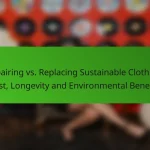Sustainable fashion is gaining traction among younger consumers, particularly Millennials and Gen Z, who value ethical practices and environmental responsibility. This demographic is increasingly drawn to eco-friendly materials, ethical production, and brand transparency, shaping their purchasing decisions. The market itself is diverse, featuring luxury sustainable brands, affordable eco-friendly options, and thriving second-hand markets, catering to a wide array of preferences and budgets.
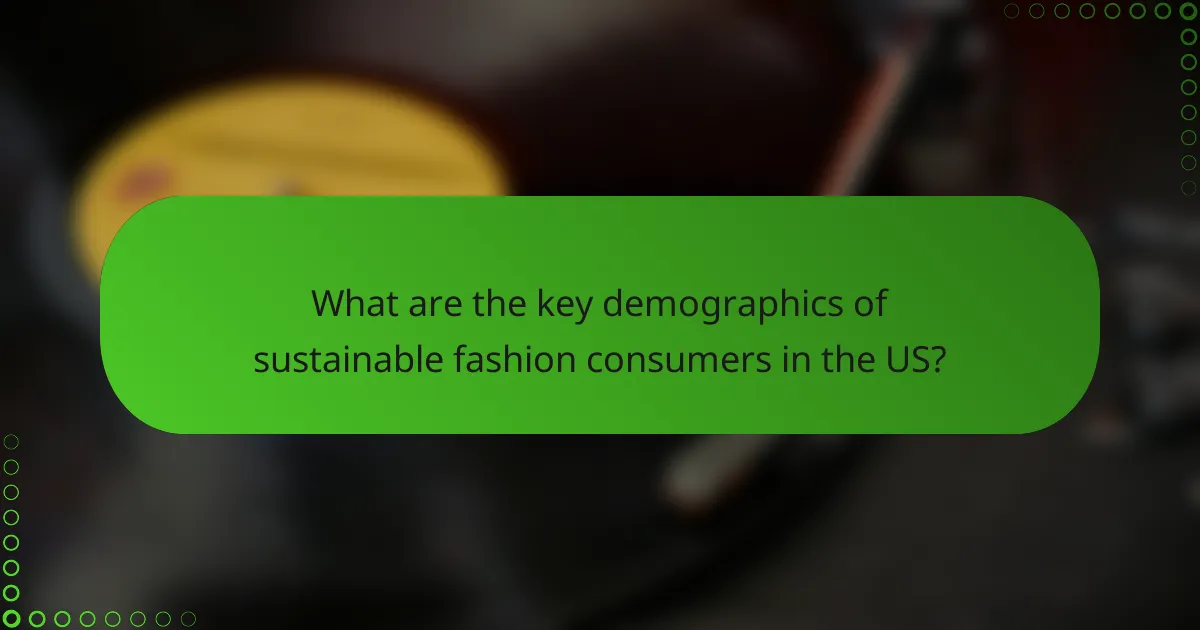
What are the key demographics of sustainable fashion consumers in the US?
The key demographics of sustainable fashion consumers in the US primarily include younger generations, particularly Millennials and Gen Z, who prioritize ethical practices and environmental responsibility. These consumers are often more educated and willing to invest in sustainable products, reflecting a growing trend towards conscious consumption.
Millennials as primary consumers
Millennials represent a significant portion of the sustainable fashion market, often driving trends and influencing purchasing decisions. Their values align closely with sustainability, leading them to seek brands that emphasize eco-friendly materials and ethical labor practices.
This demographic is typically more engaged with social media, which amplifies their awareness of sustainable brands and practices. As a result, they are likely to support companies that demonstrate transparency and commitment to environmental issues.
Gender distribution trends
Gender distribution among sustainable fashion consumers shows a notable trend, with women generally leading in engagement and purchasing. Studies indicate that women are more likely to prioritize sustainability in their buying choices, often seeking out brands that reflect their values.
However, there is a growing interest among men in sustainable fashion, driven by increased awareness of environmental issues and a desire for stylish yet responsible clothing options. This shift suggests a potential for broader market growth as more men embrace sustainable practices.
Income levels influencing purchases
Income levels significantly influence sustainable fashion purchases, with higher-income consumers more likely to invest in premium sustainable brands. These consumers often have the financial flexibility to choose quality over quantity, favoring brands that offer longevity and ethical production.
Conversely, lower-income consumers may face challenges in accessing sustainable options due to higher price points. Brands that offer affordable sustainable alternatives can tap into this market segment, making eco-friendly choices more accessible to a wider audience.

What preferences drive sustainable fashion choices?
Preferences for sustainable fashion are primarily influenced by a desire for eco-friendly materials, ethical production practices, and brand transparency. Consumers increasingly prioritize these factors as they seek to minimize their environmental impact and support responsible brands.
Eco-friendly materials
Eco-friendly materials are a cornerstone of sustainable fashion. Fabrics made from organic cotton, hemp, and recycled materials reduce environmental harm and resource consumption. For instance, organic cotton uses significantly less water and avoids harmful pesticides compared to conventional cotton.
When choosing sustainable clothing, look for certifications such as Global Organic Textile Standard (GOTS) or OEKO-TEX, which ensure that materials meet stringent environmental and safety criteria. Brands that use these materials often highlight them in their marketing, making it easier for consumers to make informed choices.
Ethical production practices
Ethical production practices encompass fair labor conditions, safe working environments, and fair wages for workers. Brands committed to these practices often engage in transparent supply chain management, ensuring that their products are made responsibly. This commitment can significantly influence consumer purchasing decisions.
To support ethical production, consumers can research brands that are certified by organizations like Fair Trade or the Ethical Trading Initiative. These certifications indicate adherence to high labor standards and can guide shoppers toward more responsible choices.
Brand transparency
Brand transparency refers to how openly a company shares information about its sourcing, production processes, and overall impact on the environment. Consumers increasingly demand transparency, as it builds trust and allows them to make informed decisions about their purchases.
Look for brands that provide detailed information on their websites regarding their sustainability practices, including supply chain details and environmental impact assessments. Brands that are willing to disclose this information often demonstrate a genuine commitment to sustainability, making them more appealing to conscious consumers.
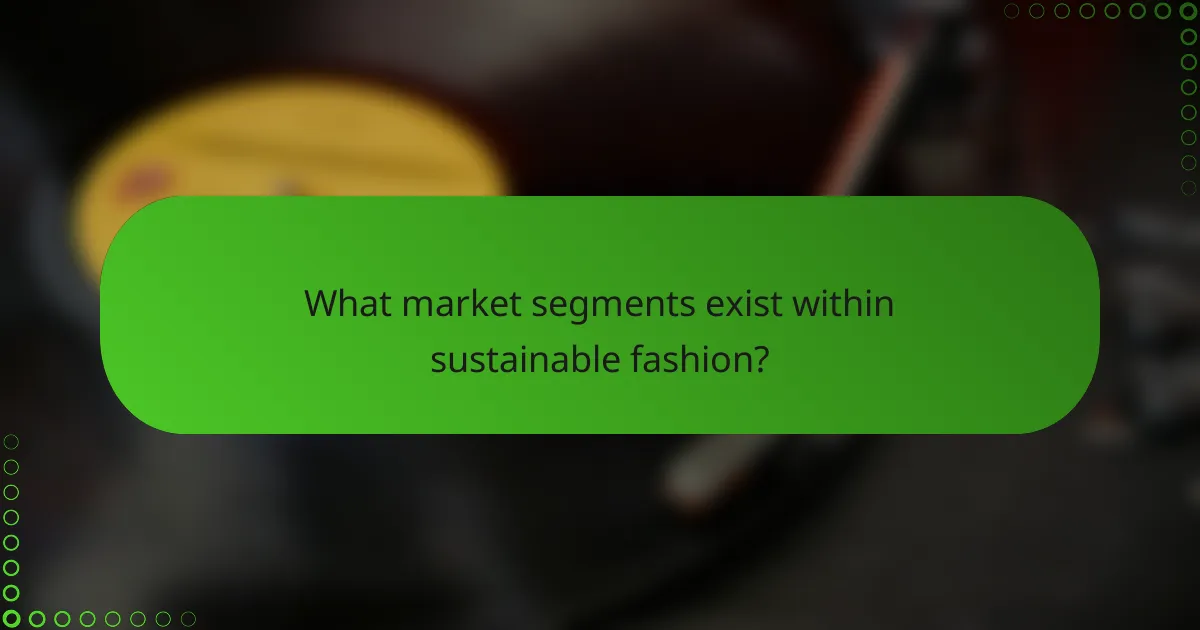
What market segments exist within sustainable fashion?
The sustainable fashion market comprises several distinct segments, each catering to different consumer preferences and budgets. These segments include luxury sustainable brands, affordable eco-friendly options, and second-hand or thrift markets, providing a range of choices for environmentally conscious shoppers.
Luxury sustainable brands
Luxury sustainable brands focus on high-quality materials and ethical production practices, appealing to consumers who prioritize both style and sustainability. These brands often emphasize craftsmanship, limited editions, and transparency in their supply chains.
Examples include Stella McCartney and Gabriela Hearst, which are known for their commitment to eco-friendly materials and ethical labor practices. Consumers in this segment are typically willing to invest significantly in pieces that align with their values.
Affordable eco-friendly options
Affordable eco-friendly options cater to budget-conscious consumers seeking sustainable fashion without breaking the bank. Brands in this segment often use organic materials and sustainable practices while keeping prices accessible.
Popular examples include H&M’s Conscious Collection and Uniqlo’s sustainability initiatives, which offer stylish clothing at lower price points. This segment appeals to a broad audience, making sustainable fashion more inclusive.
Second-hand and thrift markets
Second-hand and thrift markets have gained popularity as consumers look for unique pieces while minimizing waste. This segment includes thrift stores, online resale platforms, and vintage shops, offering a wide range of styles at various price points.
Platforms like Depop and Poshmark facilitate the buying and selling of pre-owned clothing, making it easy for consumers to participate in sustainable fashion. This option not only reduces waste but also allows shoppers to find one-of-a-kind items at lower costs.
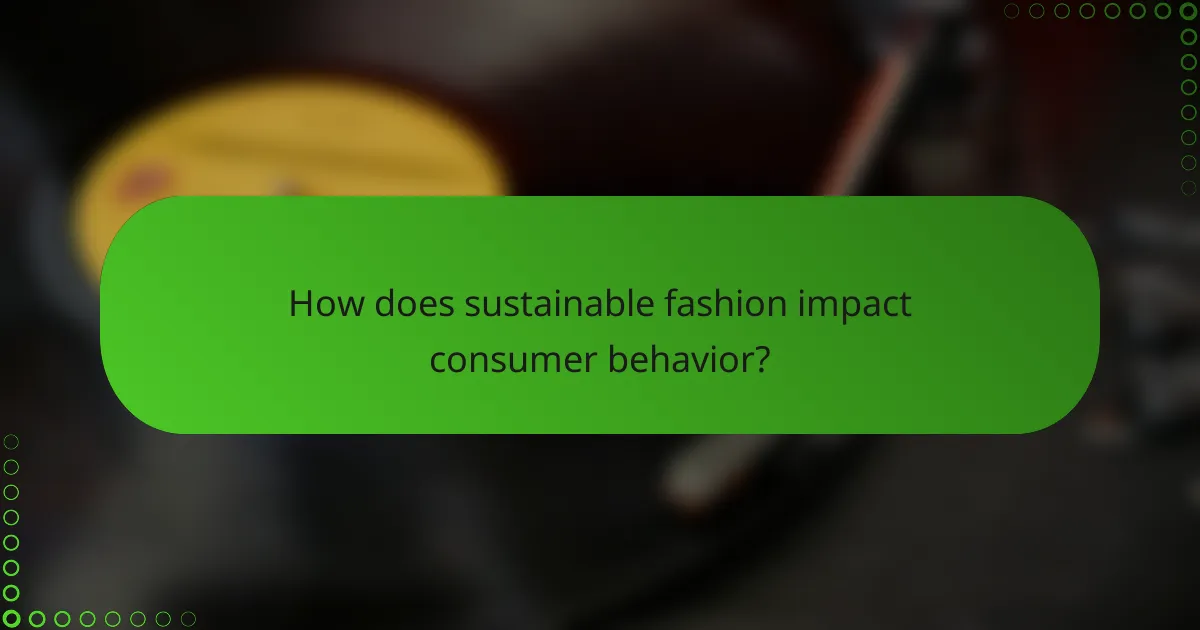
How does sustainable fashion impact consumer behavior?
Sustainable fashion significantly influences consumer behavior by encouraging more conscious purchasing decisions. Consumers are increasingly prioritizing brands that demonstrate environmental responsibility and ethical practices, leading to a shift in market dynamics.
Increased brand loyalty
Consumers who value sustainability often develop stronger loyalty to brands that align with their values. This loyalty can translate into repeat purchases and positive word-of-mouth, as satisfied customers share their experiences with like-minded individuals.
Brands that actively promote their sustainable practices, such as using eco-friendly materials or fair labor conditions, can foster a deeper emotional connection with their customers. This connection often results in a willingness to pay a premium for products that reflect their beliefs.
Influence of social media
Social media plays a crucial role in shaping consumer perceptions of sustainable fashion. Platforms like Instagram and TikTok allow brands to showcase their sustainable practices and engage with consumers directly, making sustainability a trending topic.
Influencers and user-generated content can amplify the message, making sustainable choices more appealing. As consumers share their sustainable fashion finds, they contribute to a community that values ethical consumption, further driving demand for responsible brands.
Shift towards minimalism
The rise of sustainable fashion is closely linked to a broader cultural shift towards minimalism. Consumers are increasingly opting for quality over quantity, seeking timeless pieces that can be worn for years rather than fast fashion items that quickly go out of style.
This shift encourages individuals to invest in versatile, durable clothing that aligns with their values. Brands that offer minimalist designs made from sustainable materials are likely to attract consumers looking to simplify their wardrobes while making environmentally conscious choices.
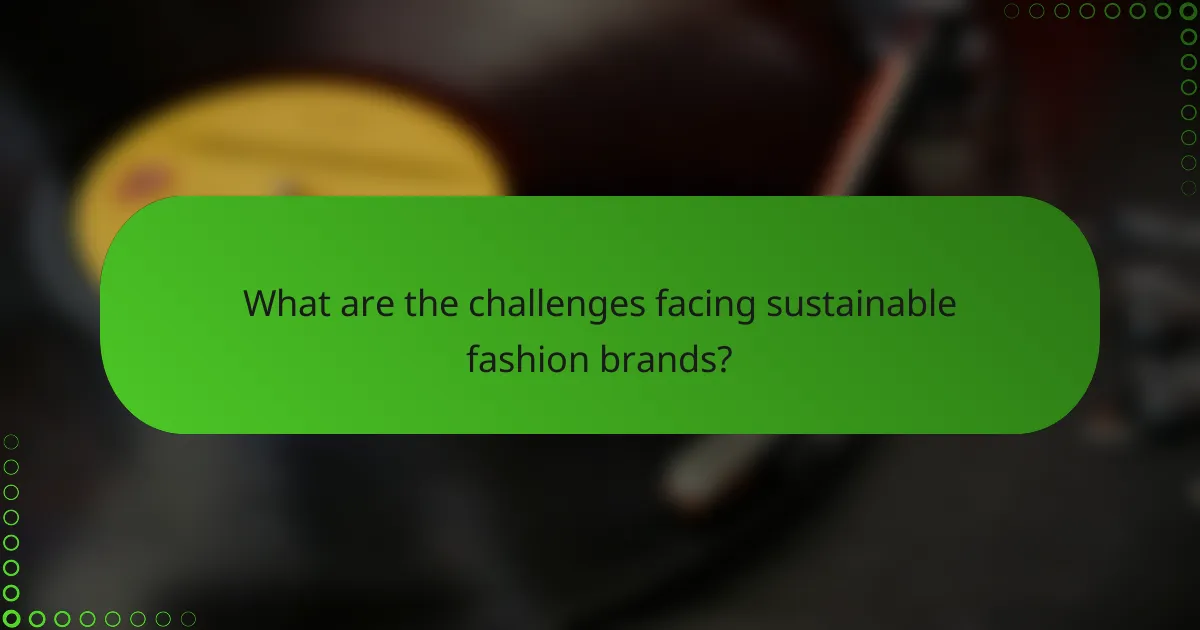
What are the challenges facing sustainable fashion brands?
Sustainable fashion brands face several significant challenges that hinder their growth and impact. Key issues include supply chain transparency, higher production costs, and consumer misconceptions about sustainability.
Supply chain transparency issues
Supply chain transparency is crucial for sustainable fashion, yet many brands struggle to provide clear information about their sourcing and production processes. This lack of visibility can lead to skepticism among consumers who want to ensure their purchases align with ethical standards.
To improve transparency, brands can adopt traceability technologies, such as blockchain, which allow consumers to track the journey of their clothing from raw materials to retail. However, implementing these systems can be complex and costly.
Higher production costs
Producing sustainable fashion often incurs higher costs due to the use of eco-friendly materials and ethical labor practices. Brands may face production costs that are significantly higher than conventional fashion, which can lead to increased retail prices.
To manage these costs, brands can explore partnerships with local artisans or invest in innovative materials that reduce waste. Additionally, educating consumers on the value of sustainable practices can help justify higher prices.
Consumer misconceptions
Many consumers hold misconceptions about sustainable fashion, believing it to be unaffordable or less stylish. These beliefs can hinder the market’s growth, as potential buyers may opt for cheaper, conventional options.
Brands can combat these misconceptions through effective marketing strategies that highlight the quality, durability, and style of sustainable products. Engaging storytelling and influencer partnerships can also help reshape consumer perceptions and increase demand.

How do marketing strategies differ for sustainable fashion?
Marketing strategies for sustainable fashion focus on transparency, ethical practices, and environmental impact, distinguishing them from conventional fashion marketing. Brands often emphasize their commitment to sustainability through targeted messaging and community engagement.
Storytelling in brand messaging
Storytelling plays a crucial role in sustainable fashion marketing by creating an emotional connection with consumers. Brands often share narratives about their origins, the artisans involved, and the sustainable materials used, which resonate with eco-conscious shoppers.
Effective storytelling can include visuals and testimonials that highlight the brand’s journey towards sustainability. For instance, a clothing line might showcase the process of sourcing organic cotton or the impact of fair trade practices on local communities.
To enhance storytelling, brands should focus on authenticity and relatability. Avoiding overly polished narratives can help consumers feel more connected to the brand’s mission and values, fostering loyalty and trust.





